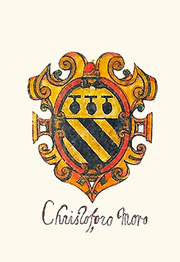
Cristoforo Moro
Encyclopedia

Doge of Venice
The Doge of Venice , often mistranslated Duke was the chief magistrate and leader of the Most Serene Republic of Venice for over a thousand years. Doges of Venice were elected for life by the city-state's aristocracy. Commonly the person selected as Doge was the shrewdest elder in the city...
. He reigned from 1462 to 1471.
Family
The Moro family settled in Venice in the mid-12th century when Stephanus Maurus, agreat-grandson of Maurus, built a church on the island of Murano
Murano
Murano is a series of islands linked by bridges in the Venetian Lagoon, northern Italy. It lies about 1.5 km north of Venice and measures about across with a population of just over 5,000 . It is famous for its glass making, particularly lampworking...
. Cristofor was the eleventh person from the family to be elected doge.
Life
After graduating from university, Moro held various public offices. He was the Venetian ambassador to the Popes Eugene IV and Nicholas V. Saint Bernardino of SienaBernardino of Siena
Saint Bernardino of Siena, O.F.M., was an Italian priest, Franciscan missionary, and is a Catholic saint.-Early life:...
was said to have prophesized that Moro would one day become doge, and as the fulfillment of a solemn vow Moro had the Church of Saint Giobbe
San Giobbe
The Church of St Job is a Roman Catholic church in Venice, northern Italy, dedicated to Saint Job. It is located in the Cannaregio, overlooking the campo of the same name, known as Sant'Agiopo in Venetian, on the left bank of the Cannaregio canal at Ponte dei Tre Archi...
built and dedicated to Bernardino's memory. He bequeathed his fortune to various charitable organizations and foundations, including the Church of Saint Giobbe.
Doge
Moro's reign was marked by the beginning of a long warOttoman–Venetian War (1463–1479)
The First Ottoman–Venetian War was fought between the Republic of Venice and her allies and the Ottoman Empire from 1463 to 1479. Fought shortly after the capture of Constantinople and the remnants of the Byzantine Empire by the Ottomans, it resulted in the loss of several Venetian holdings in...
between Venice and the Turks. In 1463 Pope Pius II sent Moro a consecrated sword with the intention of convincing Venice to join the anti-Turk alliance. The reaction in Venice was initially hesitant as the Republic's main priority was their economic interests.
In April 1463, 10 years after the conquest of Constantinople, Turkish troops occupied the Venetian fortress of Argos
Argos
Argos is a city and a former municipality in Argolis, Peloponnese, Greece. Since the 2011 local government reform it is part of the municipality Argos-Mykines, of which it is a municipal unit. It is 11 kilometres from Nafplion, which was its historic harbour...
in Greece. The Latin Patriarch
Patriarch
Originally a patriarch was a man who exercised autocratic authority as a pater familias over an extended family. The system of such rule of families by senior males is called patriarchy. This is a Greek word, a compound of πατριά , "lineage, descent", esp...
Cardinal Johannes Bessarion traveled to Venice to call on the Republic to join the "defense of the faith"; ie join the war against the Turks. That same year a coalition was formed between Venice, Hungary and the Albanian prince Skanderbeg
Skanderbeg
George Kastrioti Skanderbeg or Gjergj Kastrioti Skënderbeu , widely known as Skanderbeg , was a 15th-century Albanian lord. He was appointed as the governor of the Sanjak of Dibra by the Ottomans in 1440...
with the blessing of the Pope to counter the threat of Sultan Mehmed II
Mehmed II
Mehmed II , was Sultan of the Ottoman Empire for a short time from 1444 to September 1446, and later from...
's aggressive policy of conquest. The coalition succeeded in temporarily halting Turkish expansion, however the new territorial limits acquired by the Turks in their conquests had by and large accepted.
In 1469 the Venetian fleet commander Niccolò Canal retook the town of Ainos
Aenus (Thrace)
Aenus , modern Enez in Turkey, was an ancient Greek city on the southeastern coast of Thrace. Formerly called Poltyobria , it was located near the mouth of the Hebrus River, not far from the Melas Gulf , which is formed by the Thracian Chersonesus to the east...
in Thrace
Thrace
Thrace is a historical and geographic area in southeast Europe. As a geographical concept, Thrace designates a region bounded by the Balkan Mountains on the north, Rhodope Mountains and the Aegean Sea on the south, and by the Black Sea and the Sea of Marmara on the east...
, but he was not able to defend the island of Negroponte (Euboea
Euboea
Euboea is the second largest Greek island in area and population, after Crete. The narrow Euripus Strait separates it from Boeotia in mainland Greece. In general outline it is a long and narrow, seahorse-shaped island; it is about long, and varies in breadth from to...
), a major granary of Venice, from Turkish attack. Euboea was conquered by the Sultan while inflicting enormous losses on the Venetian forces.
The Republic faced further threats from the northern Italian cities who coveted Venetian land, as well as from the French king Louis XI who was seeking to expand Lombardy
Lombardy
Lombardy is one of the 20 regions of Italy. The capital is Milan. One-sixth of Italy's population lives in Lombardy and about one fifth of Italy's GDP is produced in this region, making it the most populous and richest region in the country and one of the richest in the whole of Europe...
at the expense of Venice.

